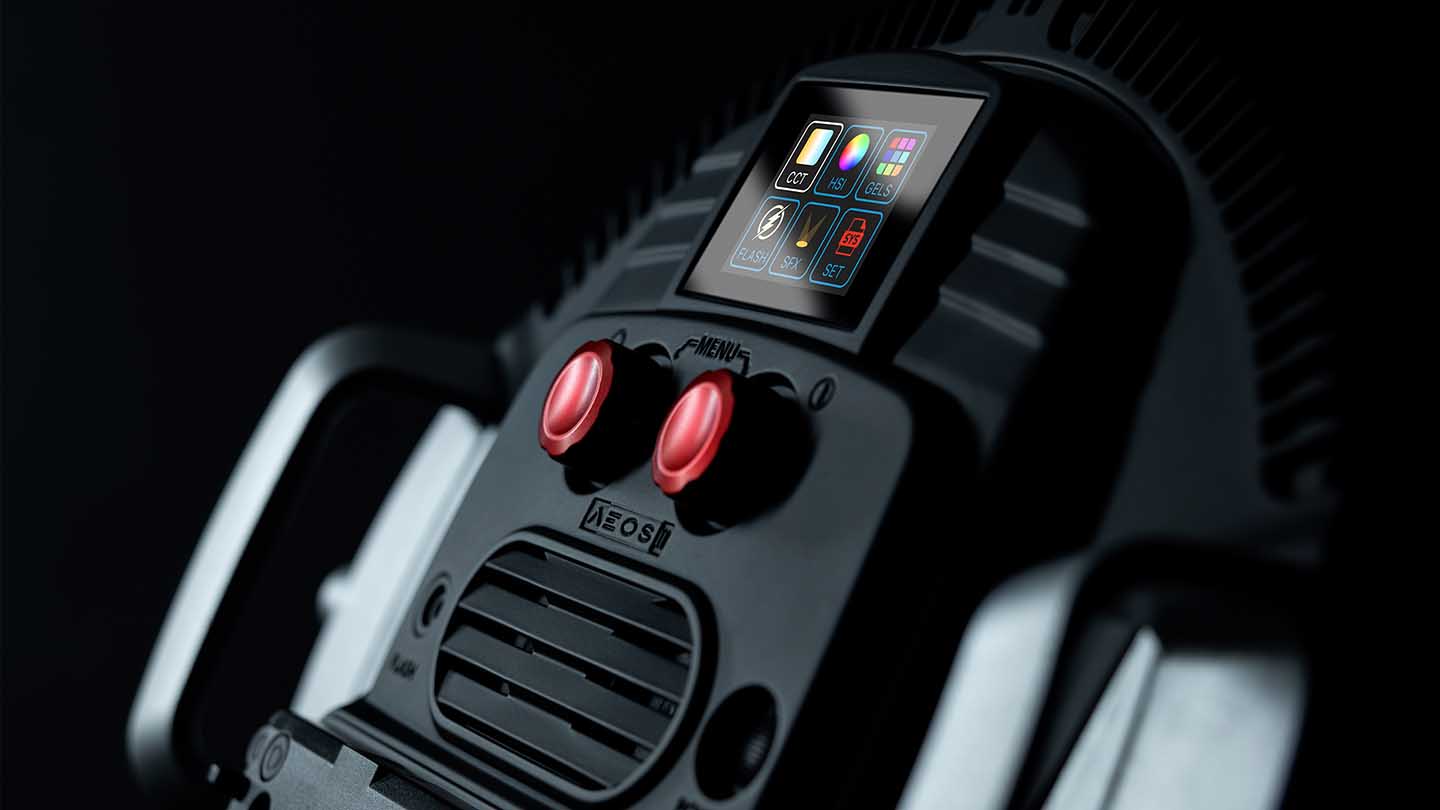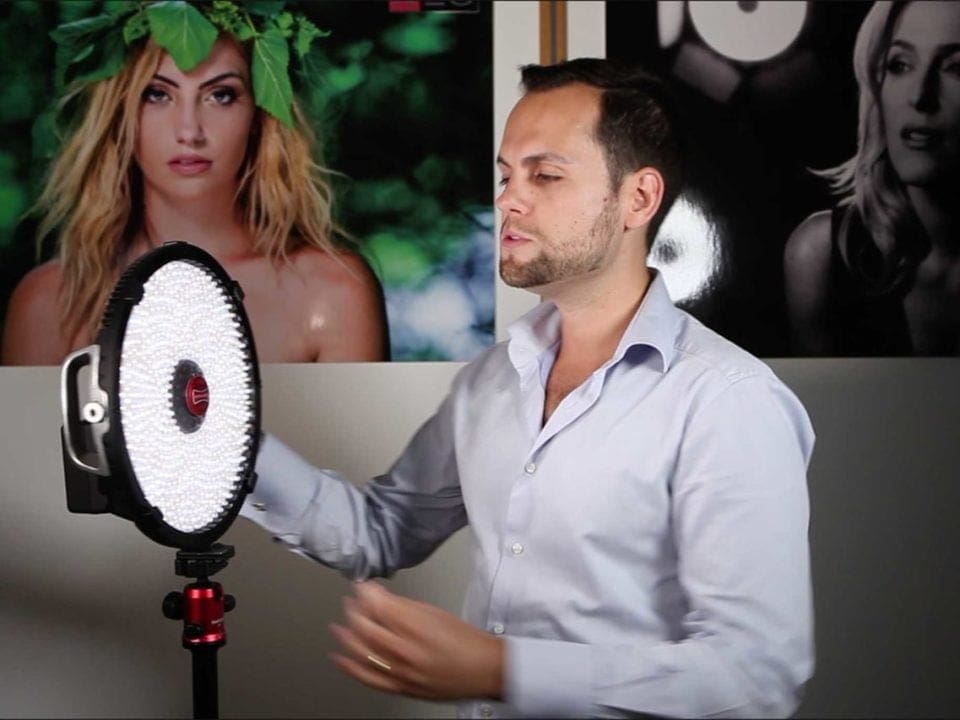Rotolight is an award-winning British LED lighting company and the Rotolight Aeos 2 is the successor to the Rotolight Aeos, a circular LED light that can be used to provide constant or flash light. Like the original Aeos, when it’s used in flash mode, the Rotolight Aeos 2 has zero recycle time. The new light is more powerful than the original Aeos, has a greater range of colour adjustment and makes use of a touch-panel for more intuitive control.
Our Verdict
Although I’ve not been able to use the flash capability or app control of the Rotolight Aeos 2 yet, I’m impressed by how easy it is to use and how quickly you can create the atmosphere that you want for a shoot. Adding app control will take things a step further by allowing to look at your phone screen rather than reaching up to wherever the light is positioned.
For
- Flash or continuous light
- Touchscreen control
- Companion app
What is the Rotolight Aeos 2?
Specification
- Product type: Portable LED light: continuous or flash
- Power: Mains or V-lock battery
- Mount: Yoke or handles
- Flash trigger: Cable or via an Elinchrom Skyport – a wireless flash receiver is built-in
- White balance range: 3,000-10,000K
- Colour range: 16.7 million colours (RGBWW)
- Filter options: 2500
- Maximum output at 3ft: Continuous: 11,500 Lux, Flash: 17,500 Lux
- Aperture value at ISO 100/200/400 in continuous mode: At 3ft: f/13, f/18, f/22, at 9ft: f/3.5, f/4.5, f/ 6.3
- Colour accuracy TLCI: 99
- CRI: 95
- Power consumption: 120W
- Dimensions: 295x25mm
- Weight: Under 1.4Kg
Features
According to Rotolight, the Aeos 2 is 140% more powerful in continuous mode than the original Aeos and up to 3-stops powerful in flash mode. It produces 11,500 lux over one meter in continuous mode and 17,500 lux in flash mode.
Its white balance can be adjusted across 3000-10,000K, plus there are 2,500 digital filters that enable you to replicate Lee and Rosco filters without using gels. In fact, it can produce up to 16.7 million colours.
On the back of the Aeos 2 there are two adjustment knobs, just like the original, but the display screen has been upgraded to a full-colour touch panel that makes selecting options you want and making adjustments very easy.
Further good news is that the Aeos 2 has Bluetooth and Wi-Fi connectivity built in and this enables the light to connect to a smartphone for app control.
There’s also an an Elinchrom Skyport wireless flash receiver built into the Aeos 2, which means that it can be triggered wirelessly using a transmitter on the camera. It will sync at shutter speeds up to 1/8000sec, making it a great option for shooting fleeting moments and action.
Naturally, Rotolight has given the Aeos 2 its CineFX suite of effects which enable it to replicate the impact of a fire, lightening, a television, gunshots or flashlights and more. That means it’s not just useful for lighting a set, it can also be used to create atmosphere in a movie.
Rotolight introduced SmartSoft technology with its flagship lights, the Titan X2 and X1. The necessary software is also in the AEOS 2. This allows the light’s diffusion to be adjusted electronically via an electric diffusion panel that is sold separately.
Build and handling
I was invited along to a shoot with Creativity Hub, a photographic experience provider based in the UK and a long-time user of Rotolight’s lights to check out an early sample of the Aeos 2. As it wasn’t a full-production sample, the Aeos 2 could only be used in constant mode and the app control wasn’t available, but it still delivered what we needed to capture interesting portrait images.
Within a few seconds of being introduced to the Rotolight Aeos 2, I was able to take control of the colour settings and to make adjustments using the combination of the touch-control panel and the knobs on the back of the light. It’s very intuitive to use.

There are six options on the homepage to access different control areas: CCT mode, in which you get control over the Kelvin value, HSI (hue, saturation and intensity), Gels to access the the 2,500 different digital filter effects, Flash to control flash power and duration, Special Effects to to select the lighting effects and lastly, system Settings where you can control aspects such the Wi-Fi connection and screen brightness. You just tap on the option you want and then use the screen to select further options and make adjustments. You can use slider controls on the touchscreen or the knobs to adjust the values.
I was shooting with the Sony A7 IV in a ‘White Witch’ themed set and I created a blue light to give the atmosphere I wanted. Interestingly, the blue colour confused the camera’s face and eye detection so that the Eye AF didn’t work, but it was easy to get the subject’s eye’s sharp using a small AF point instead.
Rotolight Aeos 2 sample images
These images were captured using the Sony A7 IV at Creativity Hub‘s ‘Winter through the Wardrobe’ themed photographic event at which a series of sets were created with a selection of fantastic models wearing fashion from some of the UK’s most exciting female designers.
Early verdict
I’ve been using the Rotolight Aeos and Rotolight Neo 2 lights for a few years and I love their simplicity, but the two-knob and basic interface can be a bit frustrating at times. Switching to a full-colour touchscreen makes everything clearer and you can adjust settings very quickly.
The additional power available with the Aeos 2 is also very exciting and I’m looking forward to seeing what it can do in flash mode.
Following a very successful Kickstarter campaign, the Rotolight Aeos 2 is now available to pre-order from Wex Photo Video in the UK and Adorama in the USA.



